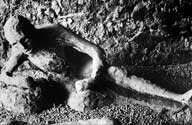Sheel Parekh
Death and destruction are a part of the tragedy of human existence, yet their essential insignificance is never as starkly highlighted as when nature’s fury bears down on us, devastating life and property. History or myth, both are replete with accounts of disasters that have destroyed entire cities, entire civilizations, even. For instance, the volcanic eruption of Thera in the 15th or 14th century, which was one of the largest such eruptions in recorded history, caused the end of the Minoan civilization. This eruption may have caused earthquakes and devastating tsunamis in the region, bringing it to an end. Here are a few more such tales…
 When ashes fell from the skies
When ashes fell from the skies
On 24 August, AD 79, a cloud “of unusual size and appearance” rose up from a mountain. “…[I]ts general appearance can best be expressed as being like an umbrella pine, for it rose to a great height on a sort of trunk and then split off into branches… in places it looked white, elsewhere blotched and dirty, according to the amount of soil and ashes it carried with it… on Mount Vesuvius broad sheets of fire and leaping flames blazed at several points…” wrote Pliny the Younger in a letter.
Pliny was 17, living with his uncle in the town of Misenum at one end of the Gulf of Naples, when the volcanic eruption of Mount Vesuvius destroyed and buried the Roman city of Pompeii under 4-6 metres of ash and pumice, along with other towns like Herculaneum, Stabiae and Oplontis and the adjoining countryside. The eruption lasted for over 19 hours, with strong earthquakes also hitting the area. The ash rose up an estimated 32 km into the atmosphere, and Pompeii was quickly covered by the ash, and the flow of magma. Pliny’s uncle, who left Misenum with several warships with the intention to rescue some of the affected people, was himself a casualty of this eruption.
